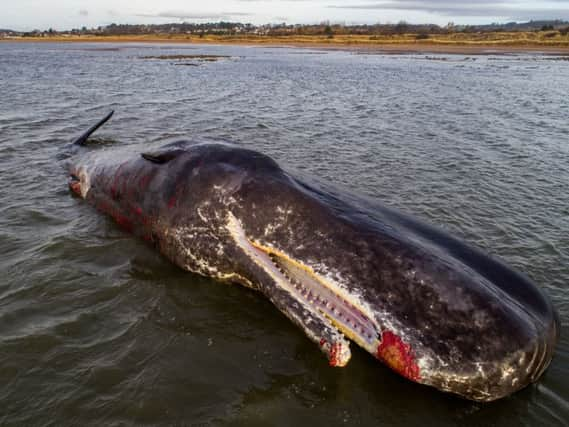Autopsy to be performed on sperm whale found on Scottish beach


Digger operators managed to crack open its skull and retrieve its brain before it started decomposing.
Dr Andrew Brownlow, head of the Scottish Marine Animal Stranding Scheme, this may never have been done before following the death of a beached whale and may lead to greater understanding of the fascinating creatures.
Advertisement
Hide AdAdvertisement
Hide AdHe said: “I have been doing this for 10 years and have never seen this. It’s more than likely it has not been done before this quickly anywhere in the world. It may have an impact on future research worldwide. It’s so very rare to manage to do this.
“The digger operator, Martin Smith, used the shovel of the digger with the precision of a scalpel to crack open its skull in the exact location we needed.”
The infant whale, which was found dead on Barry Buddon beach near Monifieth on Thursday night, was examined by experts on Friday and Saturday (23 and 24 March) before being buried under a large mound of sand.
Due to the incredible skill of digger operators from Cupar-based FTM Plant Hire, a brain sample was taken from the huge mammal before it reached decomposition.
Dr Brownlow was joined by a number of students from the St Andrews Sea Mammal Research Unit and fellow marine rescuer volunteers.
It is hoped the autopsy will allow experts to understand how the whale came to be stranded on the beach, which is both a Site of Special Scientific Interest and an EU Special Area of Conservation.
He added: “It’s just amazing to gain greater insight into these incredible animals.
“They decompose ridiculously quickly and the whale was already falling apart on Saturday.
Advertisement
Hide AdAdvertisement
Hide Ad“A post-mortem on a sperm whale is just so difficult logistically. The head is massive.
“We will be able to rule out a few possible reasons for its beaching from this sample.
“It can now be analysed for any possible issues in its brain function which could have caused it to navigate off course.
“I want to thank everyone involved in the effort. Everyone did such an incredible job.”
The British Divers Marine Life Rescue (BDMLR) team was called after sightings by a dog walker, but by the time they arrived the whale had died.
It became stranded on a stretch of shoreline between Monifieth and Barry Buddon, Angus, shortly before 6pm on Weds 21 March.
HM Coastguard from Carnoustie and Arbroath were called to assist, as was the RNLI’s inshore lifeboat at Broughty Ferry, but volunteers eventually found that the whale had died.
Paul Smith, the BDMLR’S local coordinator, revealed that an initial sighting was made by a dog walker at around 3pm, although he confirmed the sad news the whale did not survive.
Advertisement
Hide AdAdvertisement
Hide Ad“It wasn’t notified until later on but we’ve obviously responded with our team and we’ve found it subsequently dead,” he said.
“We’re just doing a search at the minute of the beach to see if it is just the one animal, and there is a possible concern of things showing up on Thursday morning.
“We’re keeping an open mind but at the minute it’s confirmed as one.”
Whales are regularly spotted in the waters off the east coast, but Mr Smith admitted it was not a usual occurrence to spot a whale of this size in the Tay.
“We get a lot of animals and there are a lot of whales traversing all these waters and migration routes,” he added.
“But it is uncommon to get big whales visiting the Tay like this – they’ll pass by certainly but it’s not very often they come in.
“The problem with sperm whales is that it’s the wrong species in the wrong area.
“They don’t do well on the east coast. “They should be on the west coast and there’s nothing out there for them to eat, so it’s more than likely it has suffered dehydration or starvation and has succumbed. It could also be ill, but we don’t know until we do a postmortem.”
Advertisement
Hide AdAdvertisement
Hide AdExperts were expected to revisit the beach at first light, but Mr Smith warned people to stay away.
“We don’t want anybody down there because this is now a biohazard,” he said.
“It’s going to start deteriorating – you can get a lot of nasty diseases from these animals so we don’t want anybody down there.”